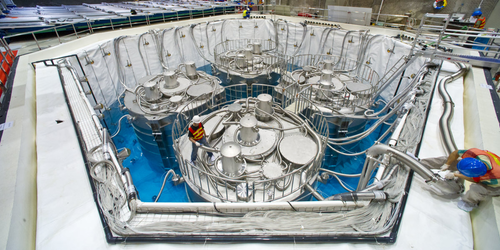Daya Bay’s Final Measurement
If the three neutrino flavors were perfectly aligned with the three neutrino mass states, neutrinos would never oscillate in flavor. But they do. Two of those misalignments, or mixing angles, and , turn out to be large; they were determined soon after flavor oscillation was confirmed in the early 2000s. But until 2012, it remained conceivable that the third mixing angle, , was exactly zero as some theorists had predicted. However, that year brought the news that researchers at the Daya Bay Reactor Neutrino Experiment in southern China had determined from just 55 days of data that is 8.8° 0.8°. Now, with 3158 days of data, the researchers have updated that value, finding that is 8.5° 0.1° [1].
The Daya Bay experiment exploits two nuclear reactors at Daya Bay and four at a sister power plant nearby. Some of the 3-MeV electron antineutrinos produced in the six reactors make their way to the experiment’s eight antineutrino detectors, which are housed in three underground caverns. Two of the caverns are situated close (500 m) to their associated power plants. The third is about 1.6 km away from all the reactors, a distance over which the electron antineutrinos should have changed flavor with a probability that depends on . Subtracting the flux at the more distant detectors from those at the nearer detectors reduces the need to make absolute measurements.
The 2012 determination that significantly exceeds zero emboldened theorists who seek answers to the preponderance of matter over antimatter in the neutrino sector. Daya Bay relied on the proximity of six nuclear reactors and on the construction of three underground caverns. Thus, its record precision could stand unsurpassed for decades.
–Charles Day
Charles Day is a Senior Editor for Physics Magazine.
References
- F. P. An et al. (Daya Bay Collaboration), “Precision measurement of reactor antineutrino oscillation at kilometer-scale baselines by Daya Bay,” Phys. Rev. Lett. 130, 161802 (2023).




